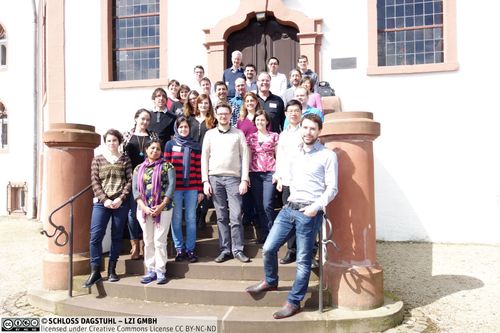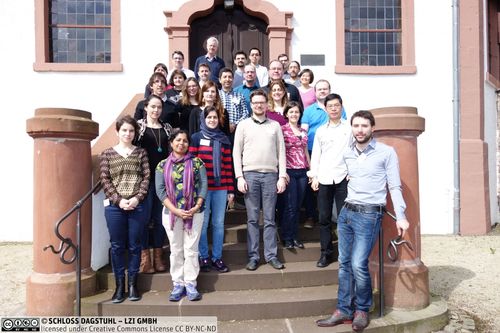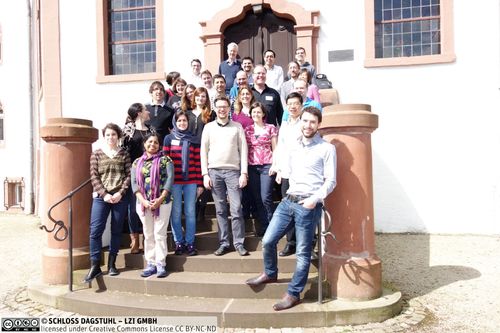Dagstuhl-Seminar 16142
Multidisciplinary Approaches to Multivalued Data: Modeling, Visualization, Analysis
( 03. Apr – 08. Apr, 2016 )
Permalink
Organisatoren
- Ingrid Hotz (Linköping University, SE)
- Evren Özarslan (Linköping University, SE)
- Thomas Schultz (Universität Bonn, DE)
Kontakt
- Andreas Dolzmann (für wissenschaftliche Fragen)
- Annette Beyer (für administrative Fragen)
Impacts
- Contour Extraction in Buildings in Airborne LiDAR Point Clouds Using Multiscale Local Geometric Descriptors and Visual Analytics : article : pp. 2320-2335 - Sreevalsan-Nair, Jaya; Jindal, Akshay; Kumari, Beena - Los Alamitos : IEEE, 2018 - (EEE Journal of Selected Topics in Applied Earth Observations and Remote Sensing ; 11. 2018, 7).
- Enforcing necessary non-negativity constraints for common diffusion MRI models : article : journal pre-proof - Haije, Tom Dela; Özarslan, Evren; Feragen, Aasa - Amsterdam : Elsevier, 2019. - 22 pp. - (NeuroImage).
- Estimation of the Permeability Tensor of the Microvasculature of the Liver Through Fabric Tensors : article in "Wittek, A.: Computational Biomechanics for Medicine" - Moreno, Rodrigo; Segers, Patrick; Debbaut, Charlotte - Berlin : Springer, 2017. - pp 71-79.
- Modeling, Analysis, and Visualization of Anisotropy - Schultz, Thomas; Özarslan, Evren; Hotz, Ingrid - Heidelberg : Springer, 2017. - x, 407 Seiten - (Mathematics and visualization). ISBN: 978-3-319-61357-4 / 3-319-61357-X.
- Prediction of apparent trabecular bone stiffness through fourth-order fabric tensors : article : pp 831–844 - Moreno, Rodrigo; Smedby, Örjan; Pahr, Dieter H. - Berlin : Springer, 2016 - (Biomechanics and Modeling in Mechanobiology ; 15. 2016, 4).
- Using gradients and tensor voting in 3D local geometric descriptors for feature detection in airborne lidar point clouds in urban regions : article in 2017 IEEE International Geoscience and Remote Sensing Symposium (IGARSS) : pp. 5881-5884 - Sreevalsan-Nair, Jaya; Jindal, Akshay - Los Alamitos : IEEE, 2017.
Multivalued data sets are generated by modern technology, such as advanced imaging methods and computational simulations, and in many applications, ranging from medicine and neuroscience to fluid dynamics and structural mechanics. In all these disciplines, we are encountering not only fields of scalars or vectors, but also of more complex quantities, often expressed as second-order or higher-order tensors, or as other higher order descriptors. Moreover, we are frequently dealing with multiple quantities that relate to different aspects of the same phenomenon, and that have to be analyzed jointly in order to understand their relationships.
Proper tools for visualization, data processing, statistical analysis and predictive modeling of multi-valued data are urgently needed, but are still hard to come by. Recent years have seen rapid scientific progress in diverse related applications and also on fundamental theoretical and algorithmic questions related to proper treatment of such data, spread over different disciplines. The goal of this workshop is to bring together scientists working on computer science, applied mathematics, physics, engineering, neuroscience, and medicine, thus enabling interdisciplinary exchange to bridge the gap between the applications and the fundamental scientific developments. This includes making sure that practitioners are aware of available methodology, and that researchers working on theory and algorithms understand what the most pressing challenges are on the application side.
In particular, we aim to address issues related to:
- Modern variants of diffusion MRI, including the use of multiple gradient pulses and flexible gradient waveforms.
- Graph-based representations of data from neuroimaging.
- Data from engineering disciplines, in which information is frequently encoded in tensor fields, which are rarely analyzed by practitioners.
- Decompositions and approximations of higher order tensors to support data analysis.
- Visual representations of state-of-the-art mathematical models for data within the scope of the seminar.
- Accounting for data uncertainty, model uncertainty, or measurement artifacts in the visualization of higher order descriptors.
- Statistical distributions and hypothesis tests for structured data, tensorial random variables, and higher order descriptors.
- Effective and computationally efficient kernels to enable predictive modeling of multivalued, tensorial, and higher-order data.
- Using Finsler geometry for the quantitative and visual analysis of higher order descriptors, especially those arising in diffusion MR imaging.
- Approximative or compressed representations of higher order data.
This Dagstuhl Seminar is the sixth in a series of stimulating, highly interdisciplinary Dagstuhl seminars. Previous seminars resulted in various collaborations and books that reflect the excitement and inspiration generated by these seminars. The charming atmosphere of Schloss Dagstuhl will prove once more to be a powerful catalyst that initiates vivid discussions, fruitful exchange of expertise, and lasting scientific relations between the participating researchers.
Topics and Motivation
This seminar is the sixth in a series of Dagstuhl Seminars devoted to the use of tensor fields and other higher order descriptors, including higher-order tensors or Spherical Harmonics, to model intricate multivalued data that arises in modern medical imaging modalities, as well as in simulations in engineering and industry. Even though the literature on image analysis, visualization, as well as statistical hypothesis testing and machine learning is quite rich for scalar or vector-valued data, relatively little work has been performed on these disciplines for tensors and higher-order descriptors.
Applications wherein such descriptors can be employed to process multivalued data range from neuroimaging to image analysis and engineering. Diffusion Weighted Magnetic Resonance Imaging (DW-MRI), an MRI modality which makes it possible to visualize and quantify structural information about white matter pathways in the brain in vivo, is one of the driving technologies, but tensors have also shown their usefulness as feature descriptors for segmentation and grouping in image analysis, including structure tensors and tensor voting. Applications in solid mechanics, civil engineering, computational fluid dynamics and geology require the processing of tensor fields as part of domain-specific modeling, simulation, and analysis (e.g. stress-strain relationships, inertia tensors, permittivity tensor).
The Dagstuhl seminar provides a unique platform by facilitating scientific exchange between key researchers in seemingly diverse applications. Despite these disciplines' commonalities in terms of the tools employed, it would be very unlikely that these scientists would attend the same conference as the theme of most conferences is defined by a specific application. By bringing together specialists in visualization, image processing, statistics, and numerical mathematics, the Dagstuhl seminar provides new impulses for methodological work in those areas.
Organization of the Seminar
To ensure a steady inflow of new ideas and challenges, we put an emphasis on inviting researchers who previously did not have the opportunity to attend one of the meetings in this series. This was true for almost half the attendees in the final list of participants.
The seminar itself started with a round of introductions, in which all participants presented their area of work within 100 seconds with help of a single slide. This helped to create a basis for discussion early on during the week, and was particularly useful since participants came from different scientific communities, backgrounds, and countries.
A substantial part of the week was devoted to presentations by 26 participants, who spent 20 minutes each on presenting recent advances, ongoing work, or open challenges, followed by ten minutes of discussion in the plenary, as well as in-depth discussions in the breaks and over lunch. Abstracts of the presentations are collected in this report. For the traditional social event on Wednesday, we went on a hike, which was joined by almost all participants, and offered additional welcome opportunities for interaction.
Three breakout sessions were organized in the afternoons, and another one in the evening, so that none of them took place in parallel, and everyone had the opportunity to visit all groups relevant to him or her. The topics of the four groups were formed by clustering topics brought up in the round of introductions, and were denoted as:
- Visual encodings and the interface between theory and applications
- Models and geometry
- Topological methods
- Multi-field and tensor group analysis
Depending on the interests of the participants, the breakout groups differed in nature, ranging from the collection of open questions and discussions on future directions of the field to spontaneous tutorial-style presentations. Notes taken during these sessions, and the main results of two of them are summarized in this report.
Outcomes
The participants all agreed that the meeting was successful and stimulating, and we plan to publish another Springer book documenting the results of the meeting. Participants have pre-registered thirteen chapters already during the seminar, and we are in the process of collecting additional contributions both from participants and from researchers working on closely related topics who could not attend the meeting. We expect that the book will be ready for publication in 2017.
It was voted that the group will apply for another meeting in this series. In addition to the current organizers Thomas Schultz (University of Bonn, Germany) and Evren Özarslan (Linköpings Universitet, Sweden), Andrea Fuster (TU Eindhoven, The Netherlands) and Eugene Zhang (Oregon State University, USA) agreed to help apply for the next event.
Acknowledgments
The organizers thank all the attendees for their contributions and extend special thanks to the team of Schloss Dagstuhl for helping to make this seminar a success. As always, we enjoyed the warm atmosphere, which supports formal presentations as well as informal exchange of ideas.
 Ingrid Hotz, Evren Özarslan, and Thomas Schultz
Ingrid Hotz, Evren Özarslan, and Thomas Schultz
- Burak Acar (Bogaziçi University - Istanbul, TR) [dblp]
- Maryam Afzali-Deligani (Sharif University of Technology - Tehran, IR) [dblp]
- Bernhard Burgeth (Universität des Saarlandes, DE) [dblp]
- Tom Dela Haije (TU Eindhoven, NL) [dblp]
- Anders Eklund (Linköping University, SE) [dblp]
- Aasa Feragen (University of Copenhagen, DK) [dblp]
- Luc Florack (TU Eindhoven, NL) [dblp]
- Andrea Fuster (TU Eindhoven, NL) [dblp]
- Hans Hagen (TU Kaiserslautern, DE) [dblp]
- Ingrid Hotz (Linköping University, SE) [dblp]
- Andrada Ianus (University College London, GB) [dblp]
- Cheng Guan Koay (Walter Reed Medical Center - Bethesda, US) [dblp]
- Chunlei Liu (University of California - Berkeley, US) [dblp]
- Georgeta Elisabeta Marai (University of Illinois - Chicago, US) [dblp]
- Rodrigo Moreno (KTH Royal Institute of Technology - Stockholm, SE) [dblp]
- Jaya Sreevalsan Nair (IIIT - Karnataka, IN) [dblp]
- Evren Özarslan (Linköping University, SE) [dblp]
- Jos B.T.M. Roerdink (University of Groningen, NL) [dblp]
- Benoit Scherrer (Harvard Medical School - Boston, US) [dblp]
- Gerik Scheuermann (Universität Leipzig, DE) [dblp]
- Thomas Schultz (Universität Bonn, DE) [dblp]
- Alexandra Tobisch (DZNE - Bonn, DE & Universität Bonn, DE) [dblp]
- Xavier Tricoche (Purdue University - West Lafayette, US) [dblp]
- Gözde Ünal (Istanbul Technical University, TR) [dblp]
- Anna Vilanova (TU Delft, NL) [dblp]
- Yue Zhang (Oregon State University, US) [dblp]
- Valentin Zobel (Universität Leipzig, DE) [dblp]
Verwandte Seminare
- Dagstuhl-Perspektiven-Workshop 04172: Visualization and Image Processing of Tensor Fields (2004-04-18 - 2004-04-23) (Details)
- Dagstuhl-Seminar 07022: Visualization and Processing of Tensor Fields (2007-01-09 - 2007-01-13) (Details)
- Dagstuhl-Seminar 09302: New Developments in the Visualization and Processing of Tensor Fields (2009-07-19 - 2009-07-24) (Details)
- Dagstuhl-Seminar 11501: Visualization and Processing of Tensors and Higher Order Descriptors for Multi-Valued Data (2011-12-11 - 2011-12-16) (Details)
- Dagstuhl-Seminar 14082: Visualization and Processing of Higher Order Descriptors for Multi-Valued Data (2014-02-16 - 2014-02-21) (Details)
- Dagstuhl-Seminar 18442: Visualization and Processing of Anisotropy in Imaging, Geometry, and Astronomy (2018-10-28 - 2018-11-02) (Details)
Klassifikation
- computer graphics / computer vision
Schlagworte
- visualization
- image processing
- tensor fields
- diffusion-weighted imaging (DWI)
- partial differ- ential equations (PDEs)
- higher-order descriptors
- feature extraction
- fiber tracking
- structural mechanics
- fluid dynamics




 Creative Commons BY 3.0 Unported license
Creative Commons BY 3.0 Unported license
